
Planning a no-till garden
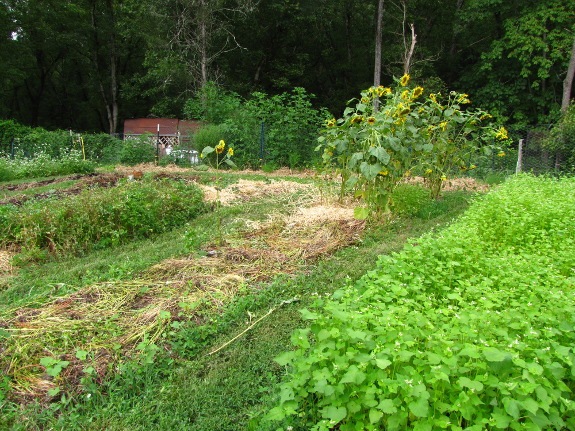
--- Kathleen
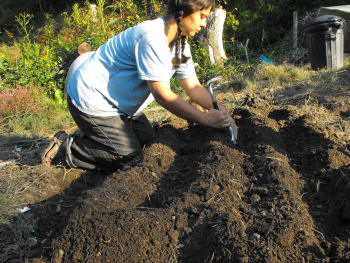
I don't really think I'm
a professional, Kathleen, but I'll answer your question as best I
can. We do own a rototiller, although it hasn't been fired up in
years. Before I knew about no-till gardens, we started garden
patches by tilling
up the ground and shovelling the topsoil from the aisles onto the beds. (Now we start new
beds by simply laying down a kill mulch, which still raises the soil,
but not by as much.)
If you use the tilling method
of starting a new raised bed, I recommend against putting anything
along the edge to hold the soil in place. Yes, without sides, a
raised bed will turn from a rectangle to a hump over time, but it's a
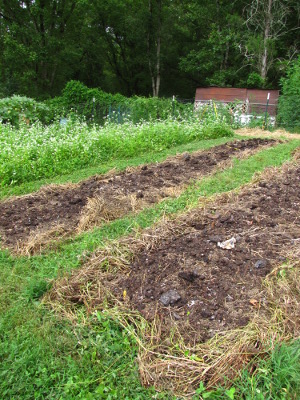 pain to try to rip out perennial weeds that have gotten their roots
under logs or boards between your raised bed and the aisle. We've
gone both edged and edgeless, and I've ended up pulling out all of the
edging (except in our sloped blueberry patch, where I figure the
mini terraces that result are worth the effort of
weeding around logs).
pain to try to rip out perennial weeds that have gotten their roots
under logs or boards between your raised bed and the aisle. We've
gone both edged and edgeless, and I've ended up pulling out all of the
edging (except in our sloped blueberry patch, where I figure the
mini terraces that result are worth the effort of
weeding around logs).
I've compared
the pros and cons of grassy and mulched aisles previously. Each method has a
place, but in our situation, grass seems to be less work and money than
mulch. If you have a free source of mulch, though, and live
beside a road, you might be better off with wood chips in the aisles.
Rocks are something I
can't speak as knowledgeably about because we just don't have
any. I seem to remember that Mark found a rock last year, and he
was so excited, he called me over to look. But my educated guess
is that rocks aren't really a problem in a no-till garden. When
tilling and digging, stones mess up your tools, but if you're not doing
either, you'd think rocks would simply add micronutrients to the soil
and increase drainage.
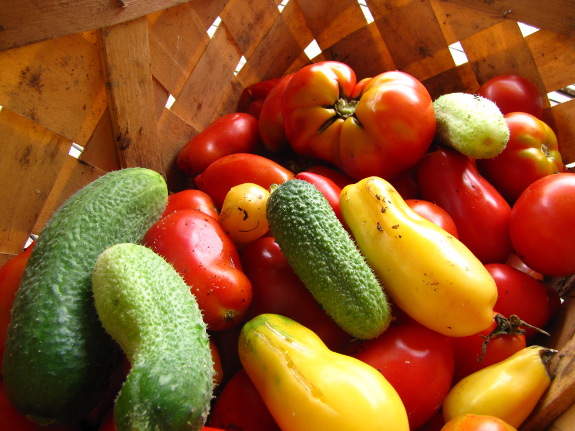
The last unanswered part
of your question is about whether you can go straight to no-till in
problematic soil. For experimental purposes, I'm glad that parts
of our garden 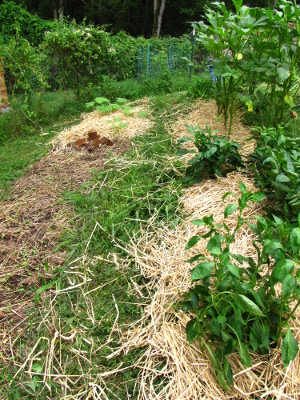 have terribly heavy,
waterlogged clay soil while other parts have light, loamy soil
(although, of course, as a gardener, I wouldn't mind if my garden were
entirely the latter). Since I've worked with both soil types, I
can tell you definitively that tilling isn't going to help your clay
and might actively harm it, while no-till methods will improve the
ground slowly but surely. What clay really needs is lots of
organic matter to fluff it up, and the fastest way to get there is by
growing cover crops whenever possible. I
highly recommend oilseed
radishes as a fall
cover crop (you can plant them right now in most parts of the U.S.)
since they can handle awful soil and will show appreciable results in
the first year.
have terribly heavy,
waterlogged clay soil while other parts have light, loamy soil
(although, of course, as a gardener, I wouldn't mind if my garden were
entirely the latter). Since I've worked with both soil types, I
can tell you definitively that tilling isn't going to help your clay
and might actively harm it, while no-till methods will improve the
ground slowly but surely. What clay really needs is lots of
organic matter to fluff it up, and the fastest way to get there is by
growing cover crops whenever possible. I
highly recommend oilseed
radishes as a fall
cover crop (you can plant them right now in most parts of the U.S.)
since they can handle awful soil and will show appreciable results in
the first year.
I hope that helps get
you off on the right foot! In case you haven't read it, I'll plug
Weekend
Homesteader: May,
which includes a section on garden planning as well as one on kill
mulching. Some of the tips there on bed and path layout might
also be handy for you, even though you didn't specifically ask about
them. Good luck!
Want more in-depth information? Browse through our books.
Or explore more posts by date or by subject.
About us: Anna Hess and Mark Hamilton spent over a decade living self-sufficiently in the mountains of Virginia before moving north to start over from scratch in the foothills of Ohio. They've experimented with permaculture, no-till gardening, trailersteading, home-based microbusinesses and much more, writing about their adventures in both blogs and books.
Want to be notified when new comments are posted on this page? Click on the RSS button after you add a comment to subscribe to the comment feed, or simply check the box beside "email replies to me" while writing your comment.

Irma --- At least you only spend $100. I've known folks who've spend that much on the borders for one fancy raised bed.... And if you live in town and need your vegetable garden to appeal to the neighbors, it might be necessary, weeds and all.
Phil --- Thanks for the followup! (And for the description of stone fence corners, which we won't be trying here, but which I enjoyed reading about. )
)
I have been using your cardboard technique with great results on the lawn I killed off (my tomatoes and squash now), compared to the other half of the garden. I have great soil, but I was depleting it over the last few years without building it back up properly. Starting on perfectly built soil the results of this mulch plus the ease of no till are my new gardening method.
I have rabbits and two chickens that add all of the soil nutrients back. They eat my weeds, kitchen and yard waste and add to the compost. My rabbit mulch was inferior to the cardboard mulch. I now let the chickens break it down now for a better compost.
I found this video and am going to try it. I have a yard waste facility near my home and the prices are reasonable for freshly mulched wood chips.
Has anyone tried this? Are the results as great as they look? I'm in Utah so lack of water is the biggest factor in my garden planning. However, it looks like this would work for any climate.
http://backtoedenfilm.com/
Thanks,
Dustin
Dustin --- I'm glad it's working so well for you!
I didn't watch the whole movie, just the trailer. (I'm not a video watcher --- it's hard enough to get me to watch two minutes when I could be reading five pages. ) So I'm not sure exactly what you're commenting on. However, I'd be a bit leery of using wood chips on the vegetable garden (although they do great in aisles and around trees, especially if partially composted). Most vegetables do better with a lower C:N ratio mulch since that leads to more bacteria than fungi in the soil, and I've found that grass clippings (when the grass isn't going to seed) and straw are their very favorite mulches.
) So I'm not sure exactly what you're commenting on. However, I'd be a bit leery of using wood chips on the vegetable garden (although they do great in aisles and around trees, especially if partially composted). Most vegetables do better with a lower C:N ratio mulch since that leads to more bacteria than fungi in the soil, and I've found that grass clippings (when the grass isn't going to seed) and straw are their very favorite mulches.
Has anyone tried doing a lasagna/sheet mulch garden and planting directly into it? I learned about this last year and helped my mother build a garden this way. We were both new to it and didn't know what to expect. We laid down newspaper and cardboard, then topped it with aged manure, hay, grass, chopped leaves, then more grass and chopped leaves-- 20-24 inches high (which seems huge but is important if you plan to plant directly into it). By spring it had sank down to about 8 inches and turned into a semi-decomposed mulch. We planted corn seeds, tomato transplants, brussel sprouts, and a bunch of squash/pumpkins and the results were AMAZING. Everything is healthy and happy, and their have been slim to no weeds. Also the weeds that make it through the mulch are much easier to pull than normal. I was surprised as I didn't expect planting directly into the "compost pile" above the kill mulch to work so well. I highly recommend this for starting a new bed- you just add a more mulch on top each fall (maybe about half as much). By the time the kill mulch is broken down fully (a couple years I'd bet) you have tons of organic matter and beautiful soil built up. I suppose that direct seeding wouldn't work for everything without a layer of compost on top, but it seems to work really well for your nutrient loving plants, and the mulch seems to deal with drought well.
Of course this method requires a lot of mulch materials at first, but it's worth it, particularly if you live near a city with a nice waste stream of leaves and grass.
Thanks for responding Anna-- Hypothetically, what if someone were starting a new garden and wanting to grow crops that wouldn't work very well planted into a sheet mulch? Would you dig in organic matter and have a standard dig garden for the first year? Or would you cover with cardboard and compost for a couple weeks until planting time and then remove it? I guess i'm confused as to when I should cover crop-- if it were fall, maybe i would lay down a kill mulch, plant some cover crops, then allow them to decompose and aid the soil over winter? It always seems like a garden spot opens up in the spring, and I'm trying to grow things in shoddy soil by digging in a little compost because I feel like I've started too late to go no-till.
I've been learning tons from your posts, so thanks a bunch.
Mike --- Here in zone 6, now is actually a perfect time to plant cover crops. Oilseed radishes and oats are my favorites because they naturally die over the winter, although if you live further south, they might not.
If you've got ground that doesn't have any bad perennial weeds --- just grasses, clovers, and run of the mill vegetable garden weeds like chickweed, sourgrass, etc --- you can lay down a simple kill mulch (cardboard and straw), then rake that back and plant your cover crops directly onto the bare soil in one month. (It won't be too late to plant the cover crops I mentioned in one month, but only if you go out and do your kill mulch this weekend. If you wait longer, you'll want to plant a cover crop like barley or rye, but will then have to commit to cutting it back and adding another kill mulch on top to really kill the cover crop in early spring.)
You can do the same thing for planting vegetable seeds that aren't keen on going into a kill mulch, but I'd let the kill mulch sit for a bit longer than a month before growing vegetables. You could lay down a kill mulch now, then rake it back and plant onto the bare soil in the spring with no problem, unless you're trying to rehabilitate a problem area full of blackberries, Japanese honeysuckle, etc. Just be sure to add a topdressing of compost in the spring!
I hope that helps clarify a bit! I know what you mean about it being tough to wrapping your head around converting to no-till and cover crops.
As a no dig gardener myself I am a bit sniffy (english term) about raised beds but I do see a need for them on some sites, e.g. those that might have drainage problems. I do not really like grass paths, potentially their roots will compete for water in the beds. I sometimes think on certain english allotments the best soil is the grass path! (But thats the harm they do by digging the plot) My own philosophy is to have no permanent paths at all. One of the advantages of no dig is you can walk on the soil without harming it- so why not have the flexibility of temporary access